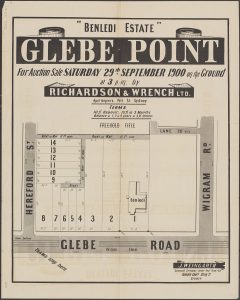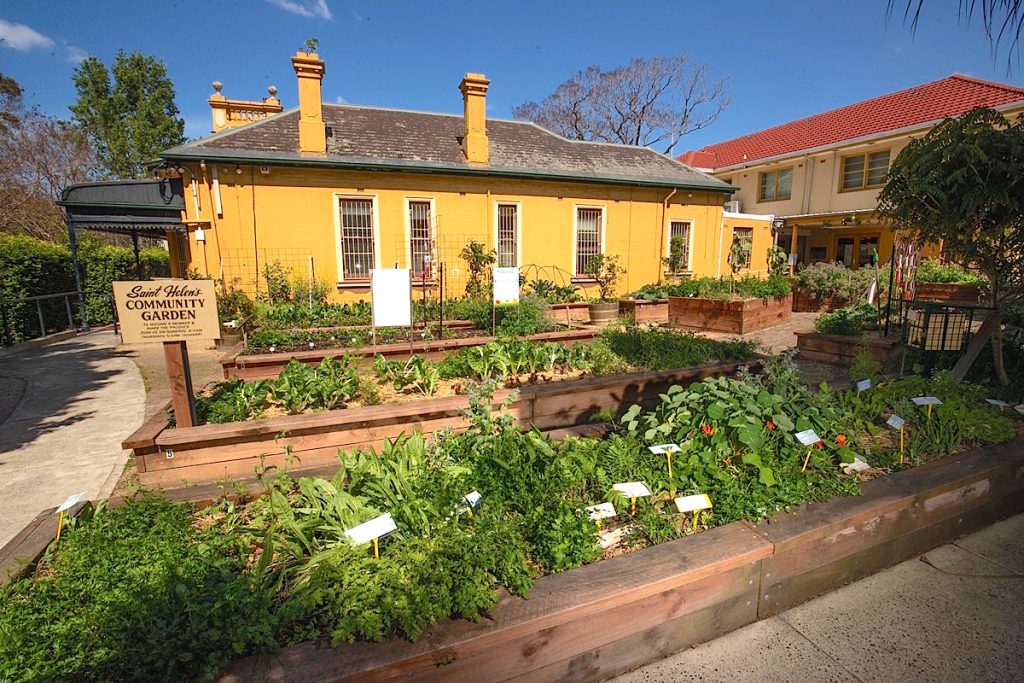By Lyn Collingwood, Bulletin 6/2023, August
In 1902 John George Bryen built St Helen’s next to Benledi on Glebe Point Road. The cottage, which today forms part of St Helen’s Community Centre, sits within just over five acres granted in 1855 to solicitor Henry Burton Bradley and was part of the Benledi Estate put up for auction in 1900. In November the next year, Bryen bought lots 2 and 3, the land stretching from the main road (his neighbouring property owners were John Howard Brown and NSW Legislative Councillor Alexander Kethel) to a lane at the rear bounding Janet Korff’s Orchard Lodge.1 By 1908 the numbering of St Helen’s was fixed as 184 Glebe Point Road.
John George’s father Stephen Josiah Bryen, an architect who trained with George Allen Mansfield, may have designed St Helen’s. The tower, out of character with the rest of the building, is probably part of the original fabric as the super-structure was fashionable at the time. George Mansfield was responsible for adding one to Toxteth House, overwhelming John Verge’s Regency design.
The Bryen Family
John George Bryen was the grandson of Irish immigrant brick maker John Bryen,2 a ‘self-made man’ who amassed a fortune. His real estate holdings included 60 acres along the Nepean River; land at Surry Hills, Burwood, Macdonaldtown, Camperdown and Forest St Forest Lodge; and the Australian Inn on the corner of Abercrombie Street and George Street West (now Broadway) which he built in 1843. Near the Kent Brewery and strategically placed on an already busy intersection, the hotel offered accommodation and stabling for teamsters travelling both west and south. Rebuilt in Art Deco style in 1938, it is today’s Abercrombie Hotel.
In June 1877 John Bryen was found dead locked up with his valuables in his Abercrombie Street home, predeceased by his wife Ellen at Redfern a year earlier. The couple had separated in later life after burying as many as ten children in the period 1837-54, their ages ranging from newborn to three years. Most were laid to rest in the Devonshire Street cemetery and reinterred with their parents at Rookwood. The sole survivor was John George’s father, born on 14 August 1848 and educated at the Collegiate School, Glebe Point.
In 1873 at St Barnabas’ Church, Stephen Josiah Bryen married Emma Howard, born on 20 June 1852 and named for her illiterate mother of Irish ancestry. Her father was Jonathan Howard, the owner of a Parramatta Road corn and produce store and a business associate of John Bryen. The newlyweds moved to a house next door to the Howards near Derby Place on Glebe Point Road. In 1874 Emma was called to the bedside of her mother who suicided by arsenic poisoning. Following the death of John Bryen, the family moved to Abercrombie Place; by 1884 they were at Lynwood on Arundel Terrace, and by 1895 were in a substantial house with the same name in Randwick. Stephen Josiah was a JP and a City Council alderman between 1884 and 1890.
The eldest of five, John George Bryen was born on 29 April 1875 and boarded at Windsor Grammar School where he was a cadet and a cross-country runner. His sisters Emma, Florence and Constance made socially successful marriages to, respectively, barrister George Harris, jeweller Thomas Alcock and the namesake son of parliamentarian Sir John See. Stephen Percy Bryen died at age 35 in 1917. Their father had died in 1909 leaving a fortune worth £95 000, the real estate including properties at Randwick and a house and 99 acres at Bowral. Their mother survived until 1924.

At Pyrmont in 1896 John George Bryen married Annie May, a daughter of Ritta and wholesale butcher Henry Macnamara of Oswestry Glebe Point Road. The Bryens’ first home was St Helen’s Myrtle Street Stanmore3. before they shifted to Arundel Terrace Forest Lodge and thence to Glebe’s St Helen’s.
The marriage was an unhappy one and as early as 1903 there was talk of divorce. Trouble was compounded by the proximity of Bryen’s in-laws. In Glebe Court in 1904 John George was bound over to keep the peace after felling Henry Macnamara to the ground. (The victim was treated for lacerations and shock by local doctor Rudolph Bohrsmann.) On a later occasion Bryen’s sister-in-law Rosa brought a suit against him for striking her and labelling her a thief and a liar and responsible for his wife having left him. Finally, in 1927, Annie was granted a judicial separation after testifying that her husband went to dances with the maid and said he wanted other women. The pair reappeared in court contesting the alimony, Annie’s counsel arguing that Bryen spent money as fast as he could to prevent her getting it. One inherited asset from which he benefited was the Australian Inn to which he added an extra storey. Renamed the Australian Hotel, it was bought by Tooth & Co.
Bryen, who always gave his profession as ‘gentleman’ or ‘of independent means’, was known for his ‘showy’ horses and traps before switching to motor vehicles and membership of the Royal Automobile Club. In 1922 he was acquitted of manslaughter when his car struck Ellen French who was alighting from a Mosman tram, and a fine on the lesser charge of reckless driving was overturned on appeal. He denied he was drunk. The next year he was fined and ordered to pay damages after knocking down another woman at Randwick. In 1930 he was convicted of drink driving and his licence suspended. Another passion was horses. He bred trotters at Moss Vale where he joined the local jockey club and donated trophies to the cricket club.
Bryen was living at St Mary’s when he died on 13 December 1947. He was privately interred in Randwick Cemetery in the family plot marked by an impressive granite obelisk. His widow died, aged 75, on 7 December 1951 and was buried in Waverley Cemetery, the resting place of her parents and other members of the Macnamara family.
The Bartlett Family
A collection of Bryen’s engravings, watercolours and furniture including two grand pianos was auctioned onsite at St Helen’s in 1905 but the house was not sold until 1911. The buyer was Glebe wholesale butcher Horatio Bartlett who bred fox terriers and, like Bryen, trotting racehorses, some of which he sold in England. Bartlett lived at number 184 Glebe Point Road with his wife Matilda Harriett née McGarvey until his death at age 79 on 2 February 1927. Following a service at St John’s Glebe, he was buried at Coogee in what is now Randwick General Cemetery.
Ownership of St Helen’s then passed to the Bartletts’ daughter Bertha Evelyn and her husband Augustus George Thomas, a Wahroonga wholesale butcher. Matilda Bartlett died in 1942, Bertha Thomas in 1953 and her widower three years later.
The Potts Family
In 1929 the Thomases sold St Helen’s to Theodore Kenneth Potts whose medical practice was at Montrose 20 Glebe Point Road. He and his wife Violet Mary gave St Helen’s as their home address until May 1932 when it was sold to Elizabeth Lawson and Stella May Clark.
The Clark Family

The births of Elizabeth and Stella to William and Jessie Clark were registered in 1881 and 1885. In 1919 the unmarried sisters established Elite Caterers at their mother’s house Walmer 280 Glebe Point Road. In June 1932 they transferred their household and business to St Helen’s. Elite Caterers specialised in wedding cakes and supplying refreshments for large social functions organised by church groups and Freemasons.
The partnership was dissolved in March 1944. Elizabeth died three months later and Stella became the house’s sole owner. She survived until 1960. Four years later St Helen’s was resumed by the Sydney Homeopathic Hospital which had occupied the adjacent building Benledi since 1914. Accommodation for nurses was built at the rear.
Local Council
Over objections raised by the Glebe Society, the Sydney Homeopathic Hospital closed in 1989. A homeopathic clinic was subsequently set up at Balmain Hospital.
In 1998 Leichhardt Council transferred to the Central Board of Health its Victoria Alice Lamkin Welfare Centre4 at 2 Hereford Street in exchange for the site. This consolidated Council’s holdings to include Benledi, St Helen’s, the nurses’ quarters and Glebe Library. A $500 000 grant was awarded by Health and Community Services to expand St Helen’s to accommodate Meals on Wheels and radio station 2RPH. The original plans included provision for a lift giving disabled access to the St Helen’s and Benledi upstairs storeys. The nurses’ quarters were earmarked for artists’ studios and a Glebe Chamber of Commerce office.
The City of Sydney Council has been the site’s landlord since 2004. In 2012 work began on transforming the grassed area between St Helen’s and Benledi into a community garden.
Notes: 1. Land Titles Office: Vol. 1379 Book 184; 2. Also spelt ‘Bryan’ and ‘Boyan’; 3. In 1925 John George was living in a third St Helen’s in Belmore Road Randwick; 4. This complex is now private accommodation. The Victorian mansion on the site is, like St Helen’s, is dominated by a tower.
Sources: Dictionary of Sydney; Glebe Society Bulletin 8/1989 and 1/1999; NSW cemetery records; NSW electoral rolls; NSW Land Titles Office online; Sands Directories; Sydney Aldermen website; Sydney Homeopathic Hospital Annual Report 1914; Time Gents website; Trove website.
See other articles about St Helen’s and Benledi












There are no comments yet. Please leave yours.